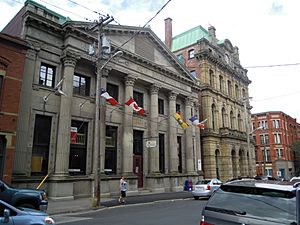Bank of New Brunswick facts for kids
 |
|
| Successor | Merged into modern-day Bank of Nova Scotia (Scotiabank) |
|---|---|
| Founded | March 25, 1820 in pre-Confederation Province of New Brunswick |
| Defunct | February 15, 1913 |
| Headquarters |
New Brunswick, Canada
|
|
Key people
|
First President: John Robinson |
The Bank of New Brunswick was a very important bank in Canada's history. It started in 1820 and was the first bank in Canada to get a special permission, called a 'charter', to operate. This bank worked on its own in New Brunswick and later in Prince Edward Island. In 1913, it joined with another bank, the Bank of Nova Scotia, which you might know today as Scotiabank.
Contents
A Look Back: The Bank's Story
How the Bank Started
The Bank of New Brunswick officially opened on March 25, 1820. This was a long time before Canada became a country (before Confederation). It was given a special permission, called a charter, by the British government.
The bank was founded in Saint John, New Brunswick by a group of important business people from the colony. At that time, Saint John was the biggest city in the Maritime Provinces. It even had more people than Halifax, Nova Scotia, and for a while, even Toronto, Ontario.
John Robinson was chosen as the first President of the Bank of New Brunswick. He led the bank until 1824. After him, Charles Simonds became the new president. The bank grew bigger when it took over the City Bank of Saint John in 1839. By 1842, the bank had £100,000 in capital, which is a lot of money!
A New Main Office
In 1877, a huge fire, known as the Great Fire, swept through Saint John. After the fire, the bank needed a new main office. A new building was built on Prince William Street in 1879.
This new building had a grand, old-fashioned look. It reminded people of a Corinthian temple, which are famous ancient Greek buildings. This building, called the Bank of New Brunswick Building, is now listed on the Registry of Historical Places of Canada.
Growing to Prince Edward Island
The bank continued to grow. In 1901, it took over the Summerside Bank of P.E.I. This helped the Bank of New Brunswick reach more customers in Prince Edward Island.
After the City Bank was taken over, Thomas Leavitt, who was the president of City Bank, became the president of the Bank of New Brunswick. Leavitt came from a family of merchants and ship owners in Saint John. Another Bank of New Brunswick building, located at 268 Water Street in Summerside, Prince Edward Island, was built between 1909 and 1910. It is also on the Registry of Historical Places of Canada.
Joining Another Bank
After Canada became a country in 1867, banks in New Brunswick faced new challenges. More money started to go to central Canada. Also, manufacturing in New Brunswick began to slow down.
Even though the Saint John Board of Trade disagreed, the government voted against a plan in 1888. This plan would have given Saint John easier access to a bigger market in New England. By the early 1900s, it became clear that the banks in New Brunswick were not getting enough money to stay competitive.
So, on February 15, 1913, the Bank of New Brunswick and its owners agreed to join with the Bank of Nova Scotia. Many of the Bank of New Brunswick's investors were putting their money into developing western Canada. Because of this, the bank's main office was moved to Montreal. Later, the Bank of Nova Scotia (Scotiabank) moved its main office to Toronto, which is now Canada's main banking and financial center.

